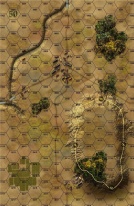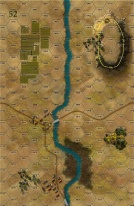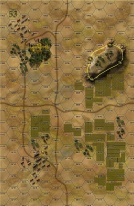|
Gates of Budapest Fire and Sword #7 |
||
|---|---|---|
|
(Defender)
Germany
(Defender) Hungary |
vs | Soviet Union (Attacker) |
| Formations Involved | ||
|---|---|---|
| Soviet Union |  |
4th Guards Mechanized Brigade |

|
| Overall Rating, 1 vote |
|---|
|
4
|
| Scenario Rank: --- of 964 |
| Parent Game | Fire and Sword |
|---|---|
| Historicity | Historical |
| Date | 1944-11-03 |
| Start Time | 10:00 |
| Turn Count | 24 |
| Visibility | Day |
| Counters | 120 |
| Net Morale | 1 |
| Net Initiative | 2 |
| Maps | 3: 50, 52, 53 |
| Layout Dimensions | 84 x 43 cm 33 x 17 in |
| Play Bounty | 193 |
| AAR Bounty | 167 |
| Total Plays | 1 |
| Total AARs | 1 |
| Battle Types |
|---|
| Inflict Enemy Casualties |
| Road Control |
| Urban Assault |
| Conditions |
|---|
| Off-board Artillery |
| Terrain Mods |
| Joint Forces Battle |
| Scenario Requirements & Playability | |
|---|---|
| Fire and Sword | Base Game |
| Introduction |
|---|
|
The 4th Guards Mechanized Brigade continued its drive toward Budapest. Early in the morning, a recon engineer platoon reached the bridge over a stream that formed part of the anti-tank ditch of the Attila I line. The Soviets attacked the crossing and quickly secured the precious bridge. Some 30 minutes later the forward detachment of the Soviet brigade arrived from the south and crossed the bridge. The Soviets organized a task force under command of Major-General Vladimir Baskakov (2nd Guards Mechanized Corps' deputy commander) which smashed through the left flank of the inexperienced SS Volunteer Cavalry Regiment 53 and then, divided into two combat teams, set out simultaneously to the north and northwest. The left flank group advanced rapidly against weak opposition from the SS militia and reached the eastern perimeter of Pestszentimre, the deepest Soviet penetration during Malinovsky's first offensive on Budapest. Pestszentimre was a typical suburb of Budapest: populated mostly by factory workers, it consisted of one- or two-story buildings, "box-houses," small agricultural gardens, vineyards, and a couple of estates. The narrow streets were perfect for ambushes and offered excellent hiding places for guns and armor. The Germans, of course, did not miss the chance to exploit these features and wasted no time unleashing hell on the Soviet spearheads to considerably slow the offensive. At 1300, Capt. Bernhard Gehrig's armored battle group of the 13th Panzer Division and a bewildering array of other German and Hungarian units counterattacked. |
| Conclusion |
|---|
|
The 4th Guards Mechanized Brigade continued its drive toward Budapest. Early in the morning, a recon engineer platoon reached the bridge over a stream that formed part of the anti-tank ditch of the Attila I line. The Soviets attacked the crossing and quickly secured the precious bridge. Some 30 minutes later the forward detachment of the Soviet brigade arrived from the south and crossed the bridge. The Soviets organized a task force under command of Major-General Vladimir Baskakov (2nd Guards Mechanized Corps' deputy commander) which smashed through the left flank of the inexperienced SS Volunteer Cavalry Regiment 53 and then, divided into two combat teams, set out simultaneously to the north and northwest. The left flank group advanced rapidly against weak opposition from the SS militia and reached the eastern perimeter of Pestszentimre, the deepest Soviet penetration during Malinovsky's first offensive on Budapest. Pestszentimre was a typical suburb of Budapest: populated mostly by factory workers, it consisted of one- or two-story buildings, "box-houses," small agricultural gardens, vineyards, and a couple of estates. The narrow streets were perfect for ambushes and offered excellent hiding places for guns and armor. The Germans, of course, did not miss the chance to exploit these features and wasted no time unleashing hell on the Soviet spearheads to considerably slow the offensive. At 1300, Capt. Bernhard Gehrig's armored battle group of the 13th Panzer Division and a bewildering array of other German and Hungarian units counterattacked. |
| AFV Rules Pertaining to this Scenario's Order of Battle |
|---|
|
| 9 Errata Items | |
|---|---|

|
The reduced direct fire value of the Heer HMG became 5-5 starting with Fall of France. (plloyd1010
on 2015 Jul 31)
|

|
All SS PzIVH tanks should have a movement of 8. (Shad
on 2010 Dec 15)
|

|
The morale and combat modifiers of German Sergeant #1614 should be "0", not "8". (Shad
on 2010 Dec 15)
|

|
All SPW 251s have an armor value of 0. (Shad
on 2010 Dec 15)
|

|
The reduced direct fire value of the SS HMG is 5-5 in Beyond Normandy and Road to Berlin. (plloyd1010
on 2015 Jul 31)
|

|
These units should have a Direct Fire rating of 2-3, just like the RKKA and NKVD counterparts. (danradz
on 2011 May 04)
|

|
All Guards JS-IIs should have AT fire values of 8-8. (Shad
on 2010 Dec 15)
|

|
Kommissars never get morale or combat modifiers. Ignore misprints. (Shad
on 2010 Dec 15)
|

|
All Guards T-34/85 tanks should have AT fire values of 7-7. (Shad
on 2010 Dec 15)
|
| Fire & Sword, scenario #7: Gates of Budapest | ||||||||||||
|---|---|---|---|---|---|---|---|---|---|---|---|---|
Fire & Sword, scenario #7: Gates of Budapest This looked like just the fun, chaos scenario I was looking to play. It has a nice mix of unit types and German/Hungarian vs. Russian nationalities. I always wanted to play with a Turan II and Hummel counters. The smaller mixed force of a few Hungarians and Germans start defending on maps 50 and 53 while a small Soviet Recon units enter on the southern edge of map 52. The Hungarian Engineer unit can attempt to blow up the bridges but only have a chance to do the Gully/Creek Bridge which it did but had no chance to reach the minor river bridge before the Soviets arrive. On turn two a huge amount of Russian Reinforcements arrive. The Axis can only dig-in or hunker down in town hexes awaiting their reinforcements. The Soviets move forward right away attacking Axis units. The German/Hungarians have two group of reinforcements that arrive on turns 7 and 9 with a roll of 6 on the dice, but I recommend they come on without the roll, as the Axis won’t last long if not. I did roll just to see what would happen and by chance rolled a 6 both attempts but I doubt that would happen again. The Soviets also get a third combat group that arrives on turn 12 and has some cool JS2s and BM13s. The victory conditions are all about what the Soviet can achieve, three of them determine the victory levels. Clearing the north-south road, eliminating more enemy steps than losing, and controlling more town hexes than the enemy. This was an interesting spread-out battle with combat happening in many areas. I still have a hard time using the various halftrack types and not losing them right away, they are great against Infantry but when armor is around they don’t last long, I guess the same for armored car when they are in scenarios. I think if the Germans don’t have early entry of their reinforcements, this scenario favors the Russians but if the Germans arrive on a schedule or early 6 rolls, the Germans have a slight edge. In my game the Germans eliminated more Soviet units and controlled half of the North-South road while the Soviets did control one town hex more than the Axis, 13 to 12 I believe, giving the Soviets only 1 out of 3 victory objectives and a Minor Axis Victory. I good first scenario from Fire & Sword. |
||||||||||||
| 0 Comments |

 FiSw006
FiSw006 























































